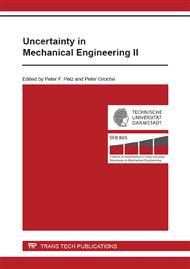[1]
H. K. Rafi, N. V. Karthik, H. Gong, T. Starr, B. Stucker, Microstructures and mechanical properties of Ti6Al4V parts fabricated by selective laser melting and electron beam melting, Journal of Materials Engineering and Performance, 22 (2013).
DOI: 10.1007/s11665-013-0658-0
Google Scholar
[2]
L. Facchini, E. Magalini, P. Robotti, S. Höges, K. Wissenbach, Ductility of a Ti-6Al-4V alloy produced by selective laser melting of prealloyed powders, Rapid Prototyping Journal, 16 (2010), pp.450-459.
DOI: 10.1108/13552541011083371
Google Scholar
[3]
D. Greitemeier, K. Schmidtke, V. Holzinger, C. Dalle Donne, Additive layer manufacturing of Ti-6Al-4V and ScalmalloyRP: fatigue and fracture, 27th Symposium of the International Committee on Aeronautical Fatigue and Structural Integrity (2013).
Google Scholar
[4]
ARCAM AB, Ti6Al4V Titanium alloy, 23. 03. (2015).
Google Scholar
[5]
S. S. Al-Bermani, M. L. Blackmore, W. Zhang, I. Todd, The Origin of microstructural diversity, texture, and mechanical properties in electron beam melted Ti-6Al-4V, Metallurgical and Materials Transactions A, 41 (2010), pp.3422-3434.
DOI: 10.1007/s11661-010-0397-x
Google Scholar
[6]
A. A. Antonysamy, Microstructure, texture and mechanical property evolution during additive manufacturing of Ti6Al4V alloy for aerospace applications, Faculty of Engineering and Physical Sciences, (2012).
Google Scholar
[7]
S. Leuders, M. Thöne, A. Riemer, T. Niendorf, T. Tröster, H. A. Richard, H. J. Maier, On the mechanical behaviour of titanium alloy TiAl6V4 manufactured by selective laser melting: fatigue resistance and crack growth performance, International Journal of Fatigue, 48 (2013).
DOI: 10.1016/j.ijfatigue.2012.11.011
Google Scholar
[8]
G. Kasperovich, J. Hausmann, Improvement of fatigue resistance and ductility of TiAl6V4 processed by selective laser melting, Journal of Materials Processing Technology, 220 (2015), pp.202-214.
DOI: 10.1016/j.jmatprotec.2015.01.025
Google Scholar
[9]
EOS GmbH - Electro Optical Systems, Material datasheet, EOS Titanium Ti64, EOS Titanium Ti64, AD, WEIL / 10. 2011, (2011).
Google Scholar
[10]
L. Eriksen, Combined EBSD-investigations and in-situ tensile tests of a direct metal deposited Ti6Al4V-alloy, Materials Science and Engineering, (2013).
Google Scholar
[11]
E. Brandl, Microstructural and mechanical properties of additive manufactured titanium (Ti-6Al-4V) using wire, evaluation with respect to additive processes using powder and aerospace material specifications, Faculty of Mechanical, Electrical and Industrial Engineering, (2010).
DOI: 10.1016/j.phpro.2010.08.087
Google Scholar
[12]
P. Edwards, M. Ramulu, Fatigue performance evaluation of selective laser melted Ti–6Al–4V, Materials Science and Engineering: A, 598 (2014), pp.327-337.
DOI: 10.1016/j.msea.2014.01.041
Google Scholar
[13]
EN 2002-001: 2005, Aerospace series - metallic materials - test methods - part 1: tensile testing at ambient temperature, G. I. f. Standardisation, (2006).
Google Scholar
[14]
EN 6072: 2010, Aerospace series - metallic materials - test methods - constant amplitude fatigue testing, Association of European Aircraft and Component Manufacturers, (2008).
DOI: 10.3403/30209689u
Google Scholar
[15]
ASTM E647-00, Standard test method for measurement of fatigue crack growth rates, ASTM International, (2000).
Google Scholar
[16]
ASTM F2924-12, Standard Specification for Additive manufacturing titanium-6 aluminum-4 vanadium with powder bed fusion, ASTM International, (2012).
DOI: 10.1520/f2924-14r21
Google Scholar
[17]
ASTM F3001-14, Additive manufacturing titanium-6 aluminum-4 vanadium ELI (extra low interstitial) with powder bed fusion, ASTM International, (2014).
DOI: 10.1520/f3001-13
Google Scholar
[18]
U.S. Department of Defense, Military handbook: titanium and titanium alloys, MlL-H DBK-697A, Washington, D.C., (1974).
Google Scholar
[19]
D. Greitemeier, V. Holzinger, C. Dalle Donne, T. Melz, Fatigue prediction of additive manufactured Ti-6Al-4V for aerospace: Effect of defects, surface roughness, in press, 28th ICAF Symposium, (2015).
DOI: 10.1179/1743284715y.0000000053
Google Scholar
[20]
ESTEC, ESA, ESACRACK user´s manual, ESA Publications Division, ESTEC Netherlands, (1995).
Google Scholar
[21]
G. Lütjering, J. C. Williams, Titanium, Springer, Berlin, Heidelberg, New York, (2003).
Google Scholar
[22]
D. Greitemeier, C. Dalle Donne, F. Syassen, J. Eufinger, T. Melz, Effect of surface roughness on fatigue performance of additive manufactured Ti-6Al-4V, in press, Materials Science and Technology, (2015).
DOI: 10.1179/1743284715y.0000000053
Google Scholar
[23]
H. Kellerer, Übersicht über die Wärmebehandlung von TiAl6V4, Härterei-Technische Mitteilungen, 25 (1970), pp.242-253.
Google Scholar
[24]
R. Boyer, G. Welsch, E. W. Collings, Materials properties handbook, titanium alloys, ASM International, Ohio, (1998).
Google Scholar
[25]
A. Gysler, G. Lütjering, Influence of test temperature and microstructure on the tensile properties of titanium alloys, Metallurgical Transactions A, 13 (1982), pp.1435-1443.
DOI: 10.1007/bf02642882
Google Scholar
[26]
S. R. Lampman, ASM Handbook, fatigue and fracture, ASM International, Ohio, (1997).
Google Scholar
[27]
D. D. Harwig, W. Ittiwattana, H. Castner, Advances in oxygen equivalent equations for predicting the properties of titanium welds, Welding Journal, 80 (2001), pp.126-136.
Google Scholar
[28]
J. A. Hall, Fatigue crack initiation in alpha-beta titanium alloys, International Journal of Fatigue, 19 (1997), pp.23-37.
DOI: 10.1016/s0142-1123(97)00047-9
Google Scholar
[29]
J. Oh, N. J. Kim, S. Lee, E. Lee, High-cycle fatigue properties of investment cast Ti-6Al-4V alloy welds, Journal of materials science letters, 20 (2001), pp.2183-2187.
Google Scholar
[30]
G. Lütjering, Influence of processing on microstructure and mechanical properties of (α+β) titanium alloys, Materials Science and Engineering: A, 243 (1998), pp.32-45.
DOI: 10.1016/s0921-5093(97)00778-8
Google Scholar


